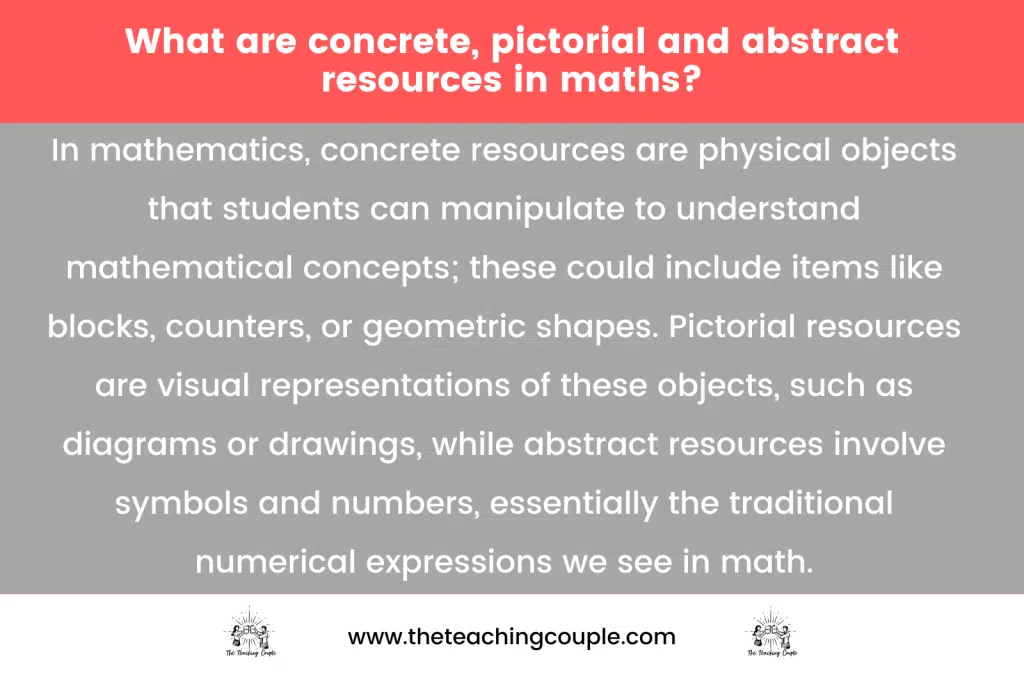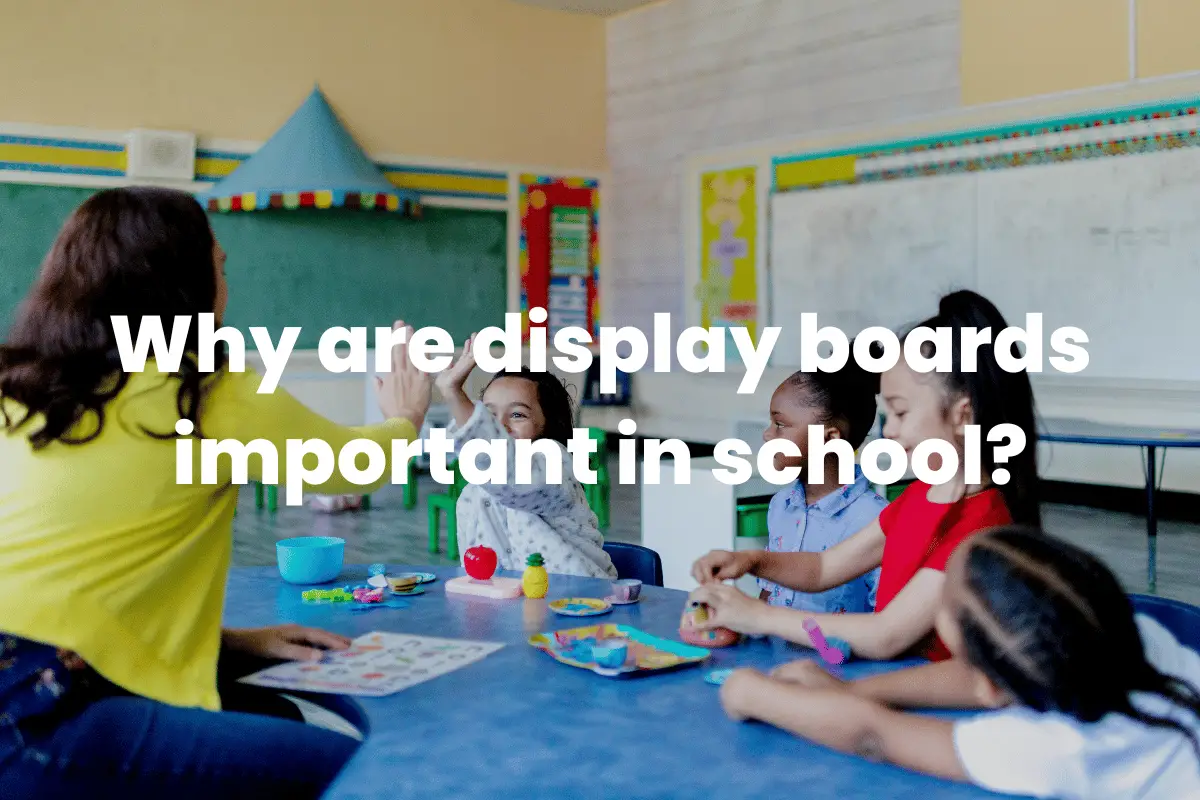Are you ready to give your students the best learning experience possible? With teaching aids, you can make your classroom dynamic and engaging, allowing kids of all ages to understand the material better.
From tactile manipulatives to educational games, there are plenty of creative ways teachers can utilize teaching aids in their lessons – let’s get started!
Related: For more, check out our article on How To Use Concrete, Pictorial and Abstract Resources In Maths here.

The Importance of Teaching Aids in Learning
Teaching aids play a crucial role in enhancing the learning experience. They not only make lessons more engaging but also help in simplifying complex concepts. By using various teaching aids like diagrams, models, charts, and multimedia presentations, educators can present information in a more accessible and understandable way.
These tools stimulate learners’ senses and make them more receptive to new information. They cater to different learning styles – visual, auditory, and kinesthetic- ensuring all students grasp the content.
Moreover, teaching aids encourage active participation, fostering an interactive learning environment. They spark curiosity and interest among students, making the learning process more enjoyable and less tedious. This ultimately leads to better retention of knowledge and improved academic performance.
Different Types of Teaching Aids
Teaching aids come in a wide variety, each serving a unique purpose to aid in the learning process. Here are some of the most common types:
- Visual Aids: These include items like diagrams, charts, maps, and graphs. They help students visualize concepts, making it easier for them to understand and remember.
- Audio Aids: Audio aids such as recordings, podcasts, and music can enhance lessons, particularly for auditory learners. They are also useful for language learning and pronunciation practice.
- Audio-Visual Aids: These aids combine both visual and auditory elements. Examples include videos, films, and multimedia presentations. They are highly effective in grabbing students’ attention and explaining complex topics.
- Tactile Aids: Tactile aids involve a hands-on approach to learning. These include models, puzzles, and games. They are especially beneficial for kinaesthetic learners who learn best by doing.
- Digital Aids: With the advent of technology, digital teaching aids like educational software, online resources, and virtual reality tools have become increasingly popular. They offer interactive and engaging ways for students to learn.
- Printed Aids: Textbooks, workbooks, flashcards, and worksheets fall under this category. They are traditional yet effective tools for providing detailed information and practice exercises.
Each type of teaching aid offers its own unique benefits and can be used individually or in combination to cater to different learning styles and enhance the overall learning experience.
How Teaching Aids Enhance Understanding
Teaching aids have a significant impact on students’ understanding of various concepts. They are instrumental in breaking down complex ideas into more short, digestible chunks. Here’s how they accomplish this:
Visual Representation: Teaching aids like diagrams, charts, and models visually represent abstract or complicated concepts. Students can grasp these concepts more quickly and thoroughly by seeing them visually.
Engagement and Interaction: Interactive teaching aids such as games, simulations, and digital tools foster an engaging learning environment. This active involvement in the learning process enhances students’ understanding as they are not just passive recipients of information.
Catering to Different Learning Styles: Not all students learn the same way. Some are visual learners, others are auditory learners, and some learn best through physical activity. By using a variety of teaching aids, educators can cater to these different learning styles, thereby improving understanding for all students.
Reinforcing Learning: Teaching aids also serve as practical tools for reinforcing what has been taught. For instance, flashcards and quizzes help revise and retain information, ensuring long-lasting learning.
The Role of Teaching Aids in Retaining Information
Teaching aids are effective in conveying information to students and play a significant role in helping them retain that information. Here’s how:
Repetition and Reinforcement: Teaching aids like flashcards, quizzes, and games allow for repetition and reinforcement of concepts, which is crucial for long-term memory retention.
Engaging Multiple Senses: Many teaching aids engage more than one sense, which helps to improve memory recall. For example, audio-visual aids stimulate sight and hearing, making the learning experience more immersive and memorable.
Creating Associations: Visual aids such as diagrams, charts, and mind maps can help students create associations between different pieces of information, making it easier to remember details.
Active Learning: Interactive teaching aids require students to participate actively in learning rather than passively absorbing information. This active engagement promotes more profound understanding and better retention.
Motivation and Interest: Teaching aids can make learning more enjoyable and exciting. When students are interested in what they’re learning, they’re more likely to remember it.
Incorporating Teaching Aids into Lesson Plans
Incorporating teaching aids into lesson plans can significantly enhance the learning process. Here’s how educators can effectively do this:
Understand the Learning Objectives: The first step is clearly defining what the students need to learn from a particular lesson. This will help select the most appropriate teaching aids aligned with the learning objectives.
Consider the Learners’ Needs: Considering their needs and preferences is crucial. For instance, if a class has more visual learners, diagrams, charts, or videos may be more effective.
Integrate Variety: Use a mix of different types of teaching aids to cater to various learning styles and keep the lessons enjoyable. This could include a blend of visual aids, audio aids, printed materials, and digital tools.
Plan for Interaction: Whenever possible, incorporate interactive teaching aids that encourage student participation. This could involve group activities, games, or hands-on experiments.
Test and Review: After implementing a teaching aid, it’s important to review its effectiveness. This can be done through quizzes, discussions, or feedback from students. If a particular aid isn’t working as expected, don’t hesitate to try something different.
The Impact of Teaching Aids on Student Engagement
Teaching aids have a significant influence on student engagement. They transform the conventional way of teaching, making it more interactive and exciting for students. Here’s how they impact student engagement:
Stimulating Interest: By appealingly presenting information, teaching aids stimulate curiosity and interest among students. This can be particularly beneficial for complex or dry topics that might otherwise be difficult to engage with.
Encouraging Active Participation: Interactive teaching aids such as games, simulations, and digital tools encourage students to participate in the learning process actively. This active involvement fosters a more profound understanding and makes learning more enjoyable.
Catering to Different Learning Styles: Not all students learn the same way. Some are visual learners, others prefer auditory information, and some learn best through physical activity. By using a variety of teaching aids, educators can cater to these different learning styles and ensure all students are engaged.
Improving Focus and Concentration: Teaching aids like videos, animations, and models can grab students’ attention and keep them focused on the lesson. This increased focus and concentration lead to better comprehension and retention of information.
Measuring the Effectiveness of Teaching Aids
To ensure that teaching aids serve their intended purpose, measuring their effectiveness is crucial. Here’s how this can be achieved:
Student Performance: One of the most direct ways to gauge the effectiveness of teaching aid is by assessing the student’s performance. A noticeable improvement in grades, comprehension, or class participation after introducing a particular teaching aid indicates that the aid is effective.
Student Feedback: Asking for student feedback can provide valuable insights into how well a teaching aid works. Students can share whether they found the aid helpful, engaging, and easy to understand.
Observation: Teachers can observe student engagement during lessons. If students appear more interested, ask relevant questions, and participate actively during lessons where teaching aids are used, it’s a positive sign that the aids are beneficial.
Comparative Analysis: Use the same teaching material with and without the aid, then compare the results. This can give a clear picture of how much the teaching aid impacts student understanding and retention.
Consistency Over Time: The true test of a teaching aid’s effectiveness is its ability to facilitate long-term learning. Regular revision sessions or tests can help determine if students retain the information taught with the aid.
Remember, using teaching aids is to enhance the learning experience. If a particular aid isn’t delivering the desired results, don’t hesitate to experiment with other types or adapt your approach.
Teaching aids can be a powerful tool to help improve student learning and should not be overlooked in the classroom. They can help increase engagement and focus, provide students with new perspectives on topics, encourage discussion and debate, and take learning from a passive act to an active one.
Not only do teaching aids support problem-solving skills and provide hands-on activities that students enjoy participating in, but they also open up pathways for understanding complex concepts that may otherwise have seemed inaccessible.
In short, teaching aids are both enjoyable and practical tools with the power to enable learners to engage with subject matter in a meaningful way. With all of these benefits from using teaching aids in the classroom, any educator or learner should consider taking advantage of them if they have not already done so.
Be sure to check out our other articles related to making learning fun and engaging!







